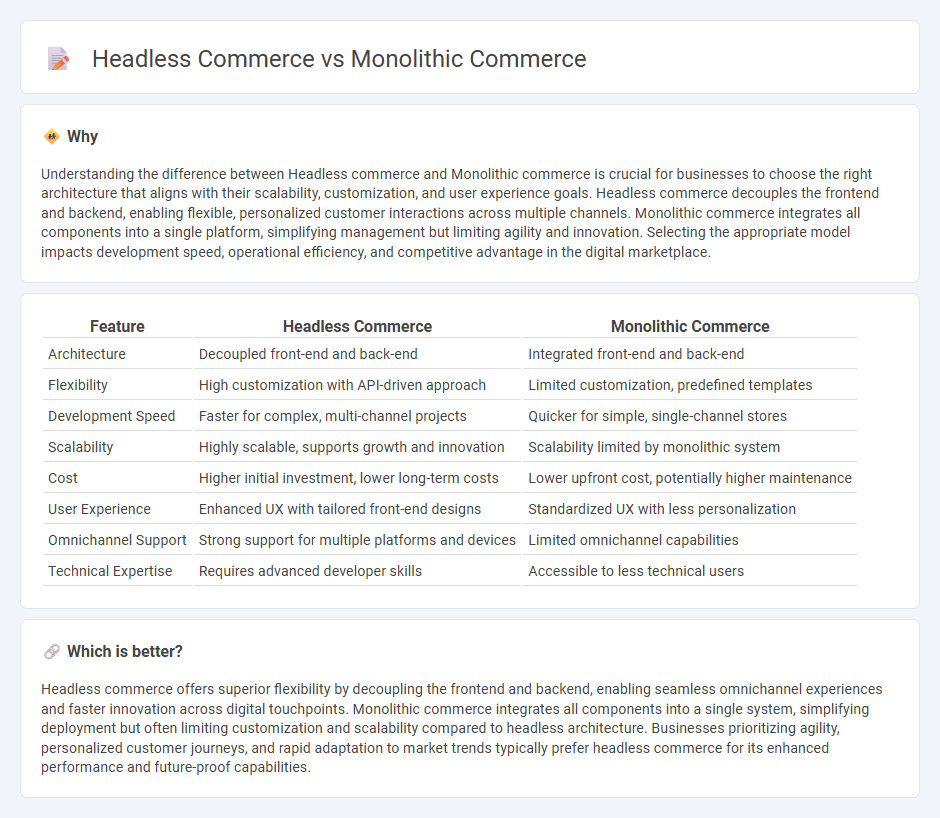
Headless commerce separates the frontend presentation layer from backend commerce functionality, enabling flexible customization and integration across multiple channels, while monolithic commerce combines both in a single system, offering simplicity but less adaptability. With headless commerce, businesses can deliver seamless omnichannel experiences and rapidly implement updates, whereas monolithic platforms often face challenges scaling and evolving quickly. Explore how these architectures influence digital retail strategies and which suits your business needs.
Why it is important
Understanding the difference between Headless commerce and Monolithic commerce is crucial for businesses to choose the right architecture that aligns with their scalability, customization, and user experience goals. Headless commerce decouples the frontend and backend, enabling flexible, personalized customer interactions across multiple channels. Monolithic commerce integrates all components into a single platform, simplifying management but limiting agility and innovation. Selecting the appropriate model impacts development speed, operational efficiency, and competitive advantage in the digital marketplace.
Comparison Table
| Feature | Headless Commerce | Monolithic Commerce |
|---|---|---|
| Architecture | Decoupled front-end and back-end | Integrated front-end and back-end |
| Flexibility | High customization with API-driven approach | Limited customization, predefined templates |
| Development Speed | Faster for complex, multi-channel projects | Quicker for simple, single-channel stores |
| Scalability | Highly scalable, supports growth and innovation | Scalability limited by monolithic system |
| Cost | Higher initial investment, lower long-term costs | Lower upfront cost, potentially higher maintenance |
| User Experience | Enhanced UX with tailored front-end designs | Standardized UX with less personalization |
| Omnichannel Support | Strong support for multiple platforms and devices | Limited omnichannel capabilities |
| Technical Expertise | Requires advanced developer skills | Accessible to less technical users |
Which is better?
Headless commerce offers superior flexibility by decoupling the frontend and backend, enabling seamless omnichannel experiences and faster innovation across digital touchpoints. Monolithic commerce integrates all components into a single system, simplifying deployment but often limiting customization and scalability compared to headless architecture. Businesses prioritizing agility, personalized customer journeys, and rapid adaptation to market trends typically prefer headless commerce for its enhanced performance and future-proof capabilities.
Connection
Headless commerce and monolithic commerce are connected through their approach to e-commerce architecture; monolithic commerce integrates the front-end and back-end into a single system, while headless commerce decouples these components to allow more flexibility in front-end development. Businesses transitioning from monolithic to headless commerce often aim to enhance scalability, customization, and omni-channel customer experiences. This connection highlights the evolution of e-commerce platforms toward more modular and adaptable systems.
Key Terms
Architecture
Monolithic commerce architecture integrates all e-commerce functionalities--product management, checkout, payment, and content--in a single unified platform, ensuring streamlined deployment but limited flexibility. Headless commerce separates the front-end presentation layer from the back-end e-commerce engine via APIs, enabling tailored customer experiences and faster innovation cycles. Explore deeper insights into how architecture impacts scalability and customization in e-commerce solutions.
Flexibility
Monolithic commerce systems integrate front-end and back-end functionalities into a single platform, limiting customization but providing simplicity for businesses with straightforward needs. Headless commerce decouples the presentation layer from back-end services, offering enhanced flexibility to deliver personalized customer experiences across multiple channels and devices. Explore the detailed comparison to understand which architecture best supports your business's scalability and adaptability goals.
API
Monolithic commerce platforms integrate all components--frontend, backend, and database--into a single system, which limits API flexibility and customization options. Headless commerce relies on decoupled architecture where APIs enable seamless communication between frontend and backend, offering greater versatility for developers to create personalized user experiences. Explore how API-driven headless commerce can transform your digital strategy for enhanced scalability and innovation.
Source and External Links
Headless e-commerce vs. monolithic e-commerce - Sitecore - Monolithic e-commerce platforms combine front-end and back-end functionalities into a single, centralized product, making them bulky and complicated to update but once the standard for seamless integration of e-commerce operations.
Composable Commerce vs Monolith Architecture: Which Approach ... - Monolithic commerce platforms tightly integrate all components into one system, simplifying setup but limiting scalability, flexibility, and customization compared to modular, API-based composable commerce.
Monolith vs. Microservices for the Modern E-Commerce Business - A monolithic e-commerce architecture unifies catalog, pricing, order management, and storefront functions into a single codebase, easing development but potentially causing scalability and maintainability challenges as complexity grows.
 dowidth.com
dowidth.com